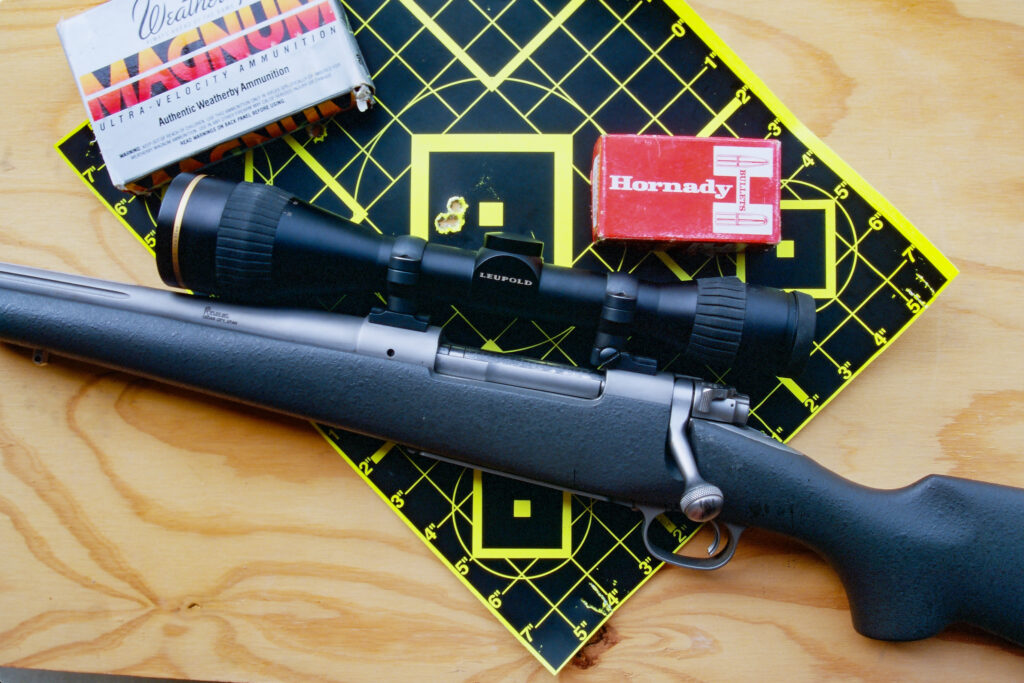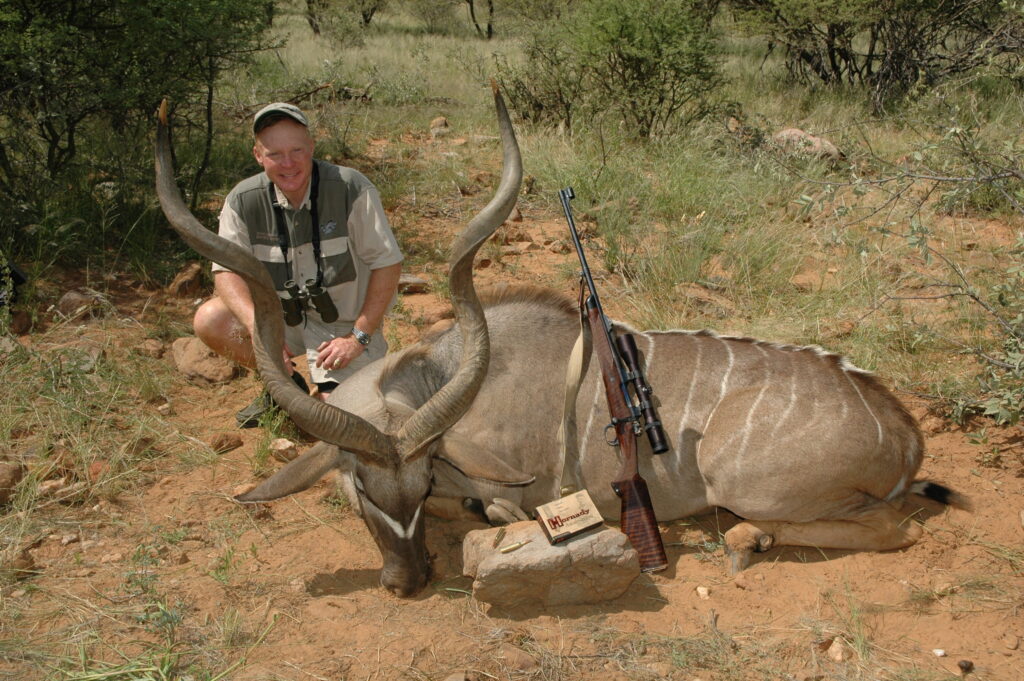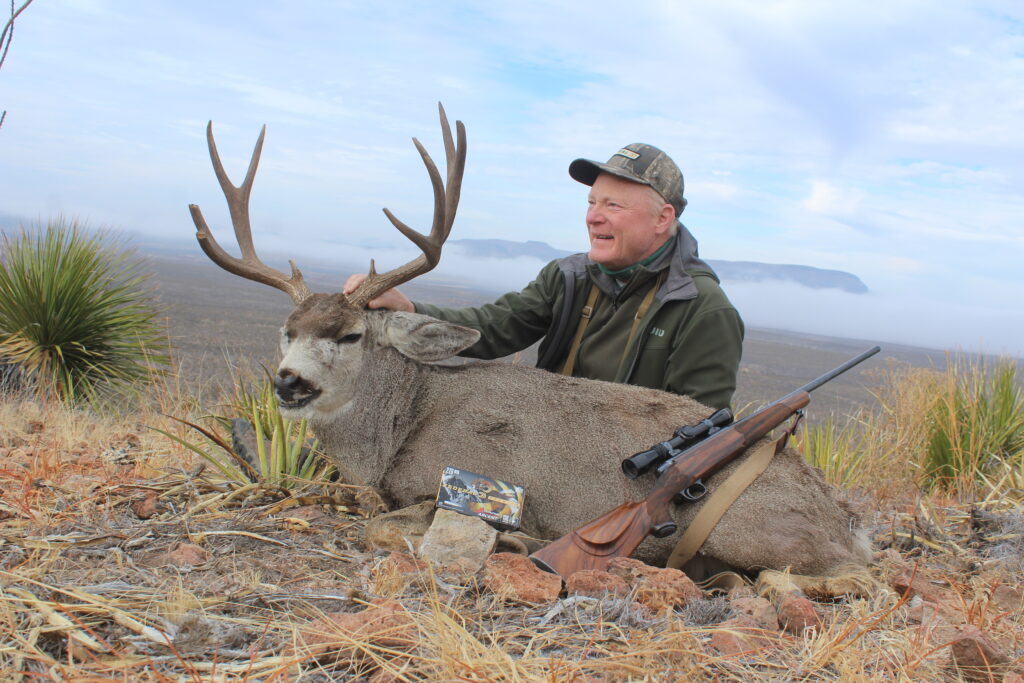What Makes A Hunting Rifle Great?
By Craig Boddington
Originally published in the May/June issue of SAFARI Magazine.
There’s truth in the adage, “Beware the man with one gun.”
My old friend Joe Bishop had an impressive gun collection, including several of our more famous SCI auction rifles. But he did almost all of his hunting (except dangerous game) with an over-the-counter synthetic-stocked Sako 7mm Remington Magnum. For him, it was “the right rifle,” and he made it talk.
During the first time we hunted together in Mozambique, we were moving along a narrow trail when a monstrous Chobe bushbuck jumped up to our right. It squirted between some trees, Joe shot, and the bushbuck vanished. It went down on the spot.
Another time, hunting whitetails in Alberta, I was on a little ridge with a stubble field below me. Joe was on a similar ridge, on the other side of the field, probably 400 yards away. Beyond the field, our guides were driving timber toward us. They jumped a good buck, and he came streaking up the center of the field at full speed. I was swinging with him hard, getting ahead, establishing my lead when he rolled out of my field of view. Then I heard Joe’s shot.
I could go on, but you get the idea. With his out-of-the-box Sako, Joe Bishop seemed more magician than rifleman. Regrettably, I never thought of asking Joe why he bought a Sako or why he chose it in 7mm Rem Mag. Now, it’s too late to ask.
Surely, we could all agree that there are many good rifles out there and a lot of fine cartridges, with redundancy and overlap in performance. Nobody can try them all.
MAKING CHOICES
So, we make our choices. Maybe they’re based on a friend’s recommendation, maybe something we read or saw in a magazine, on the internet or TV. I have no idea why Joe bought a Sako. It’s a great rifle and clearly not the only good choice. On the cartridge, I have my suspicions.
Joe was a friend of Bert and Chris Klineburger. In the years the Brothers Klineburger were opening Asian mountain hunting, they usually shared (to reduce baggage) a Remington M700 in 7mm magnum. Warren “Lefty” Page was the long-time shooting editor at “Field & Stream.” As a gun writer, he wrote about a lot of rifles. It was not so well-known that he did most of his hunting with just one rifle, a 7mm Mashburn Super Magnum on a Mauser action. In Page’s day, “Field & Stream” was America’s largest outdoor magazine. Preaching from that platform, Page steered a lot of people toward fast 7mms.
Jack O’Connor was Page’s opposite at “Outdoor Life,” then our second-largest outdoor magazine. While Page hunted a wider variety of game, O’Connor was more of a sheep hunter, outspoken in his admiration for the .270 Winchester. Many followed Professor O’Connor’s teachings and gravitated to his beloved .270, likely in the Winchester M70 action that O’Connor preferred. I knew the Klineburgers well, met Page and O’Connor was a family friend. I’ve used various .270s and fast 7mms, and I liked them all.
I first met Roy Weatherby when I was barely a teenager. Years later, when I was a young writer and new editor, Roy was especially kind to me. I’m not sure I fully bought into his theories of high velocity and hydrostatic shock, but I became a fast .30-caliber guy 40 years ago and still am.
Despite the advantages, I am not a one-gun man. I like to shoot and write about a variety of rifles. I’ve had a succession of great rifles in Roy’s flagship .300 Weatherby Magnum. I’ve also used most of the other fast .30s, from .300 H&H to .300 Win. Mag to .300 WSM, RUM and PRC. All have worked just fine. So do the fast .270s and 7mms.
With fast rifling twists, heavy-for-caliber super-aerodynamic bullets, and technology that allows us to know the range and dial the hold, I accept that the most modern cartridges, such as 6.8 Western, 27, 28, and 30 Nosler, and the 7mm and .300 PRC are probably the better mousetraps. Oh, did I leave out the fast 6.5mm’s? The fastest 6.5s are awesome for deer and mountain game but, in my long-studied opinion, as currently loaded, lack adequate bullet weight for larger game.
It’s impossible for me to use them all enough to make fair comparisons. We make our choices and become familiar with and confident in them. Then, in the inevitable campfire arguments we all love, we defend our favorites against all comers. In this, it is best to do as I say, not as I do: Find something that works for you and stick with it.
If you hunt a variety of game, different sizes and different conditions, just one probably won’t do it. Maybe a couple or three rifles that you know intimately and have full confidence in. They won’t be the only suitable choices because there are many great hunting rifles and fine cartridges. What’s important is that you believe in your choices, can make your case around the campfire, and that they are the right rifles for you.
With all the myriad choices available, you may not get it right the first time and not all apples in any barrel are perfect. It’s okay to keep learning, and upgrade (or downgrade) to find the right rifle or rifles for you. Seems to me the best choices must be based on a combination of several factors: reliable functioning, accuracy, fit and handling qualities. Then come aesthetics, which matter not at all to some of us, much to others: beauty and sense of history. Let’s look at each of these.
ABSOLUTE RELIABILITY
Since we’re talking hunting rifles, I think smooth, goof-proof functioning comes first. The darn thing must work every time, right? Most rifles do, but many of us have had issues. In 1983, when his .458 Lott was new, Jack Lott rebarreled a Remington action for me. That’s always a risk when you rebarrel a bolt-action to a differently shaped cartridge. It fed…almost all the time. But that’s not good enough for a dangerous game rifle. I loved the rifle but didn’t keep it.
In the early 2000s, I had an extended affair with the .270 WSM, an awesome mountain cartridge. The problem is that Peter Paul Mauser didn’t design his bolt-action to feed cartridges shaped like fireplugs. Some actions feed them well, but occasional stutter-feeds aren’t unusual with short, fat cartridges. In Mongolia in 2009, I shot a wolf and had a rare easy shot at a second.
The rifle stuttered, and I couldn’t get a round into the chamber. That was when I split the sheets with the .270 WSM. Most mechanical issues can be fixed. Springs, extractors, ejectors and barrels wear out. When pieces break, you can get them fixed. But I’m not going to persist with a rifle that I know has an issue, no matter how much I like it.
One of the best rifles I ever owned was a gorgeous 7mm Rem Mag by the late David Miller. I bought it used from Miller, and it fit me like a glove. The wood was gorgeous and deadly accurate, and Miller’s scope harness never shifted. Well, there will almost always be something you don’t like about a custom rifle built for someone else.
On a left-hand M700 action, this rifle had a blind magazine to keep it trim. As a personal thing, I prefer a bolt-action with a drop floorplate. I almost never load from the bottom; I prefer to top-load, and a drop floorplate is easier to clean gunk out of.
I’m also not crazy about detachable magazines. They are just one more thing to lose. That’s not a strong preference; detachable magazines are increasingly common, and some of my “right rifles” have them. However, there was one more thing about that gorgeous David Miller rifle that bothered me. Apparently, the guy who commissioned it wanted it as slim as possible because the magazine only held two cartridges.
It probably doesn’t matter on a rifle for medium game. I used it for a decade and don’t recall ever running it dry. But it was more of the idea of if I want a two-shot rifle, I’ll carry a double. Even with those minor warts, that was one of several rifles I should have kept.
ACCURACY
“Only accurate rifles are interesting.” This quote is often attributed to Warren Page. Page was also a well-traveled hunter and a benchrest guy. Among his books is “The Accurate Rifle.” However, it was gun writer Col. Townsend Whelen who gave us that famous line. I agree, but only to a point. Americans tend to worship at the shrines of velocity (thank you, Roy Weatherby) and accuracy (often demanding more than we need).
If you’re a benchrest shooter, accuracy is everything. If you’re a prairie dog shooter, you need all you can get. If you’re a big game hunter, maybe not always so much. Depends on what and where you’re hunting. Even deer-sized animals offer a comparatively large target, and the vital zone of an elk is a huge mark.
Mind you, I love accuracy because it gives confidence. Like everyone else, I want more than I need. I’m not an extreme-range shooter on game. As a matter of both ethics and practicality, I have limits. Even so, in my mountain rifles I demand the utmost in accuracy, there is no such thing as too much.
In the late 1990s, Lex Webernick (Rifles, Inc.) built me a .300 Weatherby Mag on a left-hand M70 action. In 2010, I got attracted to the modularity of the Blaser system and had one with a .300 Weatherby Mag barrel. More recently, Kenny Jarrett built me one of his lighter Ridge Walker rifles in .300 Win Mag.

For the last quarter-century, I’ve done most of my mountain hunting with these three rifles. With loads they like, all three print half-inch groups. If I were to start over, maybe I’d go with one of the modern cartridges, but I think I’m set up just fine for what little mountain hunting remains to me.
Since I’m not always chasing sheep and goats, my needs are different for a lot of hunting. We don’t have long shots in my Kansas woods, nor for the hog hunting I love, and I can’t imagine taking a longer shot at a bear. I do a lot of that stuff with lever actions.
Both old and new, some rifles surprise me, but the lever-action isn’t usually a super-accurate platform. It doesn’t matter for the hunting I do with them. If I get 2-inch 100-yard groups, I’m happy. I also do a fair amount of short-range hunting with double rifles. It’s definitely not an especially accurate platform, but fast and so much fun to use as long as the ranges are close.
In Africa, I like accuracy in a plains game rifle—not necessarily for range, but because of the great size diversity in targets. A kudu at 400 yards is one thing. An oribi or steenbok at 200 is something else again. I’ll often take one of my mountain rifles for plains game, but I’m just as likely to take an accurate, versatile deer rifle, 7×57, .270 or .30-06.

Dangerous game is a different deal. Even on leopards, pinpoint accuracy isn’t needed because shots are never far. For buffalo, accuracy isn’t an issue. Even a poorly regulated double will print both barrels inside 5 inches at 50 yards, a well-regulated gun half that. Either way, the vital zone is the size of a 5-gallon bucket. Even rifles with terrible accuracy should be good to at least 100 yards.
HOW DOES IT FEEL?
It doesn’t matter what I’m hunting; I like a rifle that’s lively and comes up fast like a good shotgun. This is probably most important on dangerous game, and that includes bears. Things can happen fast, and sometimes, you have to stand up and shoot. This has always been my philosophy. Close, fast shots can happen anywhere. Although uncommon, they even happen with mountain game. My Gobi Argali was stalked and shot in his bed at 60 yards. Years ago, I shot a Dall ram in NWT at half that.
So, while cartridges and sighting equipment may vary widely from elk to elephant, my “right rifles” all fit me and come to shoulder naturally, scope or iron sights on target.
The increased interest in long-range shooting is changing our tastes in hunting rifles. We are using bigger scopes that must be mounted higher. In plains and mountains, many of us now prefer beefier stocks, ideal for deliberate shooting from prone, but maybe not so handy in a fast, close encounter. It doesn’t matter to me. My mountain rifles don’t weigh the same (or kick the same) as my buffalo rifles, but they handle much the same.
What’s important is that your right rifle or rifles feel good to you and handle the way you want. Even more important is that you shoot them well. Here, you must be honest with yourself. To me, handling qualities are part of this; confidence in known accuracy is another part. The dread specter of recoil must also enter the picture.
My right rifles are heavier than some because gun weight is the easiest way to reduce recoil. Also, when I’m excited or out of breath, a little more gun weight is easier to stabilize. Not everyone agrees. My wife Donna’s go-to MGA .270 weighs 5.7 pounds with a full-size scope, while my Jarret is 3 pounds heavier. I think Donna’s little rifle has a lot of recoil for a .270, but it doesn’t bother her, and we’re all different in that regard.

The only thing about Joe Bishop’s beloved Sako that wasn’t straight out of the factory carton: He had it Mag-na-ported. He did that partly for recoil, and also because he felt it kept his muzzle down during recoil, which allowed him to better call his shots. Porting and muzzle brakes work. I don’t use them because they are loud, and I’ve already lost too much hearing. As a conscious decision, I carry extra gun weight instead.
Each of us has a different recoil threshold. If your rifle is kicking you to the point where you don’t look forward to shooting it, you better do something about it. Try a thicker recoil pad, muzzle brake, a half-pound of lead in the butt and the same in the fore-end channel. Or, remembering there are lots of right rifles and cartridges, just maybe you should be shooting a lighter cartridge; Fast .30s aren’t for everyone, and a .450/.400 is easier to shoot well than a .470.
BEAUTY AND HISTORY
I love good walnut and blued steel, with concessions to practicality. When I bought my Blaser R8, they didn’t offer a synthetic stock. It used to wear good walnut but is now mostly ruined, which is a shame. My .300 from Rifles, Inc. is synthetic and stainless. The Jarrett is synthetic and black Cerakote. Jack O’Connor took his beloved Biesen No. 2 .270, stocked in fine walnut, up a lot of mountains. Jack never saw a synthetic stock. I took that David Miller 7mm on one goat hunt, lamented every scratch and never carried it up into the rocks again.
Today, I have a gorgeous left-hand Joe Balickie rifle. It’s the same deal, made for somebody else, and also has a blind magazine. I can live with that. The wood is magnificent, it fits me perfectly, and its .270 Winchester chambering is classic. I have this fantasy that I’ll carry it on one of my last sheep hunts. I don’t know if I really will. It doesn’t matter how much you love it; good walnut has no place on a tough mountain hunt.
Synthetic isn’t always lighter than wood, but it’s stronger. Laminate stocks are always the heaviest and the strongest. Neither is beautiful to my eye, but beauty is in the eye of the beholder, and there’s a rugged, no-nonsense appeal to weatherproof stocks and rustproof metal. To each his own. If you like pretty guns, there are plenty of easier hunts they can go on.
As for history, I suppose it counts for little. The old .270 speaks of Jack O’Connor, the .30-06 of Hemingway, Ruark, and Townsend Whelen. My best rifle is a 7×57 on a Mauser action by Todd Ramirez. It’s a gorgeous synthetic and blue rifle. The cartridge speaks of Karamoja Bell. That 7×57 has been to a lot of places and needs to go more, but it hasn’t been up many sheep mountains.
I love cartridges with history more than I love the new whiz-bangs, even though I concede they are slightly better. This is because I know and appreciate the history, so I take greater pleasure in using them. So, given a choice, I’m more .375 H&H than .375 Ruger, more .416 Rigby than .416 Remington. But that’s me, and there is little difference in performance.
It’s more important to believe in your rifle. Also, believe in yourself. When push comes to shove, you must know you can make your right rifle do what it was made to do.
Features Editor Col. Craig Boddington is an author, hunter and longtime SCI member. He is past president of the Los Angeles Chapter, a decorated Marine and C.J. McElroy Award winner.

